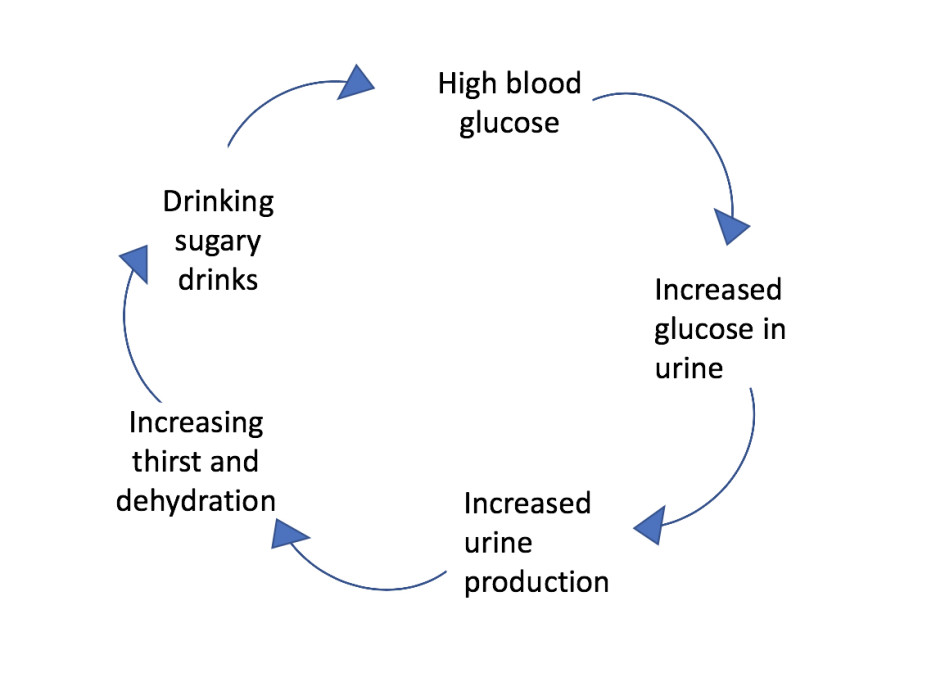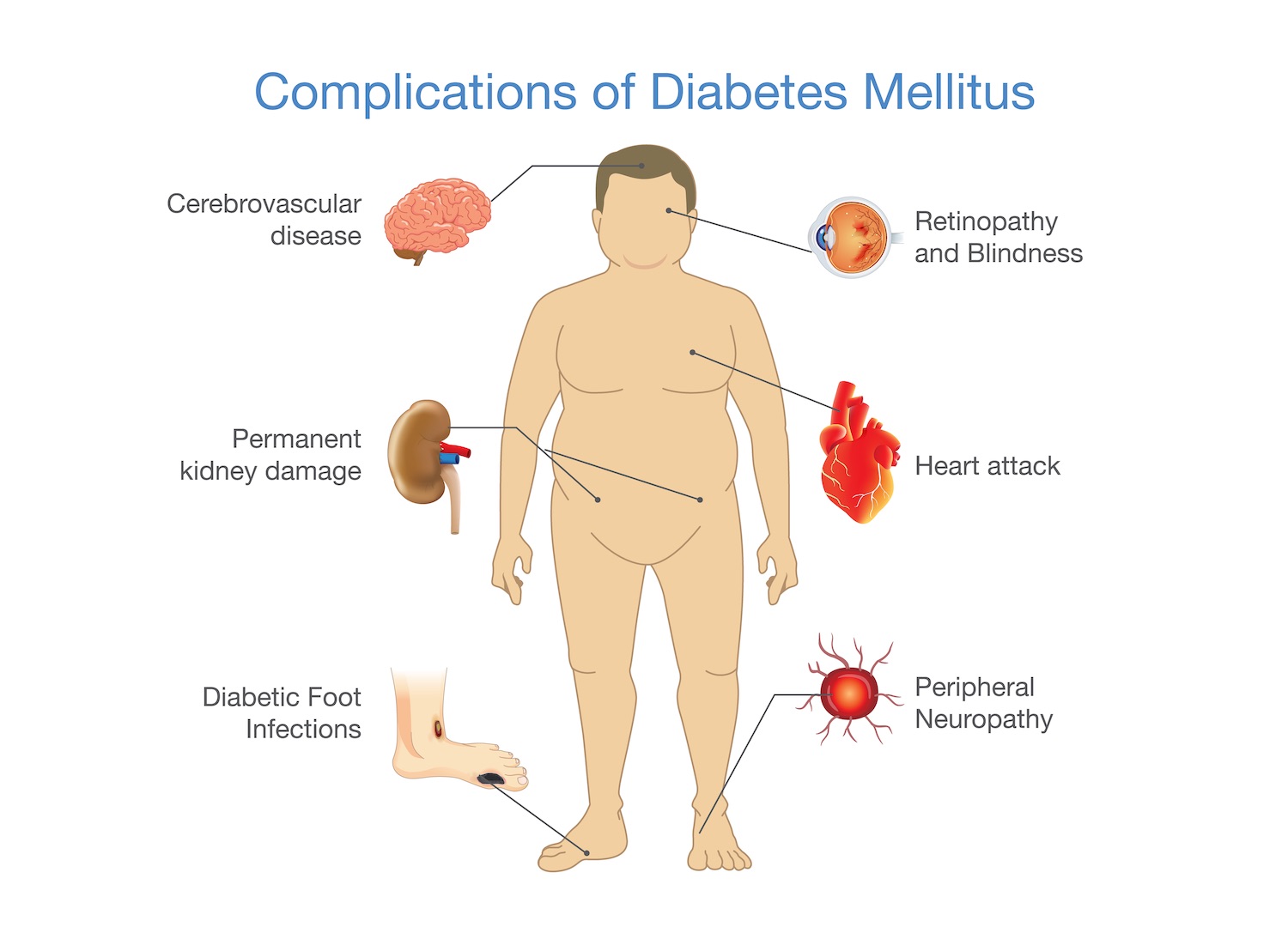How quickly do Type 1 Diabetes Symptoms Develop?
Medically reviewed by Dr Sultan Linjawi, Endocrinologist & Diabetes Specialist — December 2025

What is Type 1 Diabetes?
Type 1 diabetes explained simply
Type 1 diabetes is elevated blood sugars due to an absence or deficiency of insulin.
In diabetes, an increase in blood glucose levels occur when glucose can’t get into your fat and muscle cells where it is needed. In order for a cell in your body to gain access to glucose, it needs a small molecule called insulin. This ‘key’ unlocks the door into the cell. People with type 1 diabetes no longer produce insulin for a number of reasons.
Type 1 diabetes explained in more detail
Type 1 diabetes occurs when the pancreas, or more specifically specialised cells within the pancreas called beta cells, fail to produce insulin. Most people with type 1 diabetes develop the condition when the immune system attacks and destroys the beta cells. This is why type 1 diabetes is referred to as an autoimmune disease. Why this occurs is the source of much scientific investigation but put simply it is likely that the immune system is confused and recognises beta cells as being a foreign object (such as a virus) and wages a war against them. The fall in insulin production can either be rapid or slow. People with type 1 can therefore either develop symptoms rapidly over a few weeks or months or more slowly over a few years.
Latent autoimmune diabetes in adults (LADA)
Latent autoimmune diabetes in adults, or LADA, is a form of type 1 diabetes occurring in adulthood. Latent means that it comes on quite slowly, so the signs and symptoms of LADA has a slower course of onset compared to type 1 diagnosed in children, sometimes developing over a period of years. Because these symptoms develop slowly, LADA can be sometimes be incorrectly diagnosed as type 2 diabetes in adults.
Some of the characteristics of LADA include:
- Age of onset is 30 years and older
- Healthy weight with BMI is less than 25kg/m2
- Personal or family history of autoimmune disease
- Gradual onset
Symptoms of Type 1 Diabetes Mellitus
In diabetes mellitus, symptoms that you experience are related to:
a) the severity of diabetes, i.e. how high your blood glucose levels are,
and
b) how long you have had the condition, i.e. how long you have had high blood glucose levels for.
When a person initially develops type 1 diabetes, the beta cells of the pancreas rapidly fail to produce adequate amounts of insulin. Since there is little insulin, blood glucose levels rise very quickly. The symptoms of diabetes happen rapidly, are severe, and people notice that they are unwell quite quickly. If a person develops type 1 diabetes slowly, then these symptoms may take months to develop but often it is weeks.
Type 1 diabetes and diabetic ketoacidosis
Diabetic ketoacidosis (DKA) is a condition that occurs due to a build-up of poisonous chemicals, called ketones, in the bloodstream. DKA occurs in approximately 30% of children who present with type 1 diabetes (Diabetic Ketoacidosis in Infants, Children, and Adolescents). This causes the blood to become acidic, and the combination of acids and dehydration can lead to comas and potentially death.
DKA is a medical emergency and requires immediate medical treatment. Ketones can often be smelt on the breath and has a distinctive ‘nail polish’ smell. Low levels ketones are often normally present in prolonged starvation with or without diabetes.
In a person who has type 1 diabetes, the body isn’t able to use glucose for energy. Instead, stored fat in the body is used as a source of energy. It’s the breakdown of these fatty acids that results in the build-up of ketones, which can also appear in your urine.
Some symptoms of DKA include:
- Moderate to heavy ketones in the urine
- Rapid breathing
- Flushed cheeks
- Abdominal pain
- Sweet acetone (like nail polish remover) smell on the breath
- Vomiting
- Dehydration
What are the symptoms of type 1 diabetes?
The most common symptoms are thirst and excessive trips to the toilet to pass urine. This occurs as high blood glucose passes into the urine and with the glucose, goes water. If the blood glucose levels are very elevated, then only a small amount is able to get into the muscle and fat cells. This leads to profound weight loss and a rapid decline in muscle mass. In the early part of the illness, these symptoms can be mild and difficult to detect.
Most people with type 1 diabetes have symptoms of high blood glucose levels (hyperglycaemia). These symptoms can include:
- excessive thirst
- frequent urination
- feeling tired
- increased hunger
- unintentional weight loss
- blurred vision
- frequent yeast infections or urinary tract infections
- slow healing wounds
Excessive thirst, frequent urination, and dehydration
When your blood glucose levels are high, a lot of the glucose passes into the urine. Because you lose so much glucose in your urine, it also attracts water, meaning that you are making a lot of urine, causing you to need to pee a lot! If you are going to the toilet a lot and losing a lot of urine, then you are quickly becoming dehydrated. If you are dehydrated, you become thirsty. People who feel they need to constantly drink lots of water may have diabetes and it needs to be tested for.
If a person with high sugar tries to deal with their thirst by drinking sugar containing fruit juice or soft drinks, then the blood sugar can become even higher, resulting in even more sugar in the urine, even more urine production, and worsening dehydration. It’s a vicious cycle.

Fatigue and irritability
Fatigue is another common symptom of type 1 diabetes. You may often feel tired, regardless of how much you have eaten, because your cells are not able to use the glucose that is broken down from the food.
If you’re needing to make a lot of trips to the bathroom at night, this can also disrupt your sleep. Waking up multiple times throughout the night could mean you aren’t able to get a restful sleep, leaving you to feel tired throughout the day. This ongoing fatigue can make you easily irritable. It’s no wonder why you may be feeling more grumpy than usual!
Ongoing hunger
We get energy, like glucose, from the foods that we eat. People with diabetes, have little glucose entering the muscle cells, so the body will signal that it needs more food even though there is plenty in the blood. You may have ongoing hunger, regardless of how much you have already eaten, because the body is craving more energy.
Weight loss
If you have type 2 diabetes, there may come a time where you experience weight loss despite eating normally. This occurs when the glucose levels are very high and the pancreas is failing. This is a sign of severe diabetes. This results in not enough glucose being absorbed in the cells to be used for energy, so your body starts to breakdown fat and muscle instead, leading to the weight loss.
Blurred vision
This is a common complaint. Blurred vision occurs when glucose enters the lens in the eye ball. This causes it to swell, changing its shape and changing the refraction. This leads to a change in your eyesight. Some people will develop blurred and others might even notice an improvement in the eye sight! When the glucose levels fall back to more normal levels the lens changes shape again leading to a change in the visual acuity and a person’s eyesight. Many people are picked up as having diabetes by the opticians when they go for an eye check but is important to not get new glasses until the glucose levels are stable.
Yeast and bacterial infections
Yeast and other fungi use glucose for energy and thrive in an environment that is high in sugar. Yeast infections can occur in both men and women. Infections can grow in any place on the body that is a warm, moist fold of the skin, including:
- Between fingers and toes
- Under breasts
- In or around sex organs
People with high blood sugars also have a high risk of developing bacterial infections like urinary infections, chest infections, and skin infections and boils. The cells that fight infections are called neutrophils and their function is impaired if the glucose level is above 11mmol/l (or 200mg/dl).
Cuts and wounds that don’t heal quickly
Neutrophils, white blood cells that fight any infection in our body, are sensitive to high blood glucose levels. These are a very important part of the immune system and are at the front line of a person's defences, keeping bacterial infections at bay. In a person with diabetes, the ability of neutrophils to fight infections decreases, causing you to be less likely to able to fight infections, like a cut or a wound found on your foot.
Dry and itchy skin
When the body is dehydrated, our skin can become dry and feel itchy. Dry and itchy skin is more easily able to break, causing a cut or wound.
Complications of untreated type 1 diabetes
Complications in type 1 diabetes are all related to poor blood glucose control. Poor control of blood glucose levels over a number of years can affect the blood vessels in the body, which can result in problems with the small blood vessels (known as microvascular complications) or the large blood vessels (known as macrovascular complications). The effects on the blood vessels from ongoing uncontrolled blood glucose levels, are a major source of morbidity and mortality for people with diabetes (Microvascular and Macrovascular Complications of Diabetes).

Microvascular complications – problems with small blood vessels
Like macrovascular disease, ongoing high blood glucose levels are an important risk factor for the development of microvascular disease in patients with type 2 diabetes. Microvascular complications include:
- Retinopathy – Disease of the eye which can lead to blindness
- Neuropathy – Disease of the nerves which can lead to foot ulcers requiring amputation
- Nephropathy – Disease of the kidneys which can lead to kidney failure and the need for dialysis
Diabetic retinopathy is the most common microvascular complication of diabetes. In the U.K. Prospective Diabetes Study (UKPDS) it was found that most patients with type 1 diabetes, began to develop evidence of retinopathy within 20 years of diagnosis (Clinical Factors Associated With Resistance to Microvascular Complications in Diabetic Patients of Extreme Disease Duration).
Macrovascular complications - problems with large blood vessels
Macrovascular disease affects the larger blood vessels in our body that supply blood to the heart, brain, and legs. Macrovascular complications include:
- Coronary artery disease which can lead to a heart attack
- Cerebrovascular disease which can lead to a stroke
- Peripheral artery disease which can lead to pain deep in the leg muscles (calves, thigh, or buttocks) during activity as well as amputations.
Diabetes increases the risk of that a person will develop cardiovascular disease compared to someone who does not have diabetes. In fact, cardiovascular disease is the primary cause of death in people with type 1 diabetes (The effect of intensive diabetes treatment on resting heart rate in type 1 diabetes: the Diabetes Control and Complications Trial/Epidemiology of Diabetes Interventions and Complications study).
To learn how to regain control of your blood glucose, you can join the 12-week personalised type 1 diabetes program. When you sign up, the first week is completely free!
How is type 1 diabetes treated?
In type 1 diabetes, treatment involves two key factors:
- Checking blood glucose levels regularly to make sure they aren’t too low or too high, and
- Using insulin (through a pen or pump) to help keep blood glucose levels in a safe range
Insulin is the main treatment for people with type 1 diabetes. The goal of insulin therapy is to replace insulin that can’t be produced by the pancreas to achieve normal glucose. Since insulin is a crucial hormone that allows glucose in the blood stream to get into the muscle and fat cells, replacing insulin is necessary for people with type 1 diabetes.
There are many different types of insulin and can be classified by the onset and duration of action. These include:
- rapid acting insulin
- intermediate acting insulin
- long acting insulin
Intensive insulin therapy can be delivered by either multiple daily injections (MDI) or through continuous insulin infusion (pump).
In the Diabetes Control and Complications Trial (DCCT), it was found that intensive therapy aimed at lower levels of blood glucose, resulted in decreased rates of retinopathy, neuropathy, and nephropathy in people with type 1 diabetes (The Effect of Intensive Treatment of Diabetes on the Development and Progression of Long-Term Complications in Insulin-Dependent Diabetes Mellitus). The DCCT study also found that ongoing blood glucose control (for a period of 6.5 years) has the lasting benefit of reducing cardiovascular morbidity and mortality in people with type 1 diabetes.
Monitoring blood glucose levels in type 1 diabetes
Blood glucose levels can be monitored by self-monitoring or continuous glucose monitoring.
Self-monitoring of blood glucose levels
Self-monitoring is an integral part of type 1 diabetes therapy. It is necessary as it can indicate the amount of insulin that is required for correct dosing. Self-monitoring requires the use of a glucose meter.
Continuous glucose monitoring
Most continuous glucose monitoring devices transmit blood glucose levels every five minutes. They can even alert you if you’re experiencing a hypoglycaemic or hyperglycaemic event. Flash glucose monitoring is one type of continuous glucose monitoring.
What are the target blood glucose levels for type 1 diabetes?
Below are the target blood glucose levels for type 1 diabetes before meals and two hours after a meal.
Target blood glucose levels for Type 1 Diabetes Mellitus
| Target levels | mmol/L | mg/dL |
|---|---|---|
| Before meals | 4.0 - 8.0 mmol/L | 72 – 145 mg/dL |
| Two hours after starting meal | less than 10.0 mmo/L | less than 180 mg/dL |
DO YOU WANT TO GET YOUR DIABETES UNDER THE BEST CONTROL?
Click the program that best describes your situation.
Video Transcript
We can explore what happens in Type 1 because it really does depend on what kind of person you are and how your Type 1 diabetes evolved and developed.
If you have an interest in diabetes and you want to keep up to date then subscribe, share, comment and like this page.
So I'm just going to plot a simple graph here where we are looking at insulin production on one side against time and if we imagine that a person who doesn't have Type 1 diabetes is producing 100% of their insulin needs. And so in producing 100% of their insulin needs something comes along that produces pancreatic trauma. Now that could be immediate. And that would be something like if your pancreas is removed and that often occurs if people have chronic pancreatitis or trauma or pancreatic carcinoma.
So the more typical person who has Type 1 diabetes has a very sort of rapid onset but takes weeks to months to develop. And in this situation the pancreatic trauma that occurs is related to antibodies production. Often it follows a viral infection, the body produces antibodies against that virus but unfortunately the antibodies also seem to look for the specific cells in the pancreas that produce insulin called beta cells and it destroys them over time. And people in that situation would develop symptoms over weeks to months where the pancreatic trauma event occurs and very quickly insulin production falls very dramatically. So symptoms start quite quickly and it becomes quite obvious.
But there is another group of people with Type 1 diabetes who have a very slow progression of diabetes. And they are often misrepresented and thought of as having Type 2 diabetes because it evolves so slowly that their diabetes control can actually deteriorate over years rather than weeks. This group are called LADA or Latent Autoimmune Diabetes in Adults. So our classic description of someone developing Type 1 diabetes over weeks doesn't quite fit that mould and this group of people are often missed and are often treated with insulin very late.
And then the final group of people that we see who have a pancreatic trauma event are people who have for whatever reason a small self-limiting event which takes out a percentage of their pancreatic production. So it may be that a virus comes along the pancreas is affected, it takes about 20% of beta cell function and then they recover. And it may be that they end up still producing a decent amount of insulin and can have a great result with a small amount of insulin to top them up, it may be that they have 50% production of insulin or it might be that they even have 20% or 30%. But this group of people continue to produce insulin forever and their short term self-limiting illness kind of resolves but leaves them with an ongoing permanent reduction in insulin production that requires them to manage their insulin deficiency with insulin in the long term.
If you found this video helpful then please subscribe to the channel so that I can keep you up to date as all the new videos come online.



